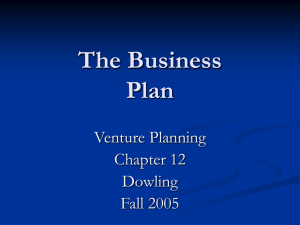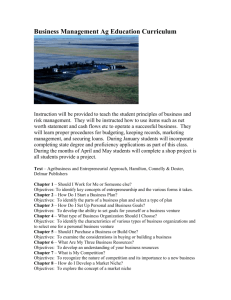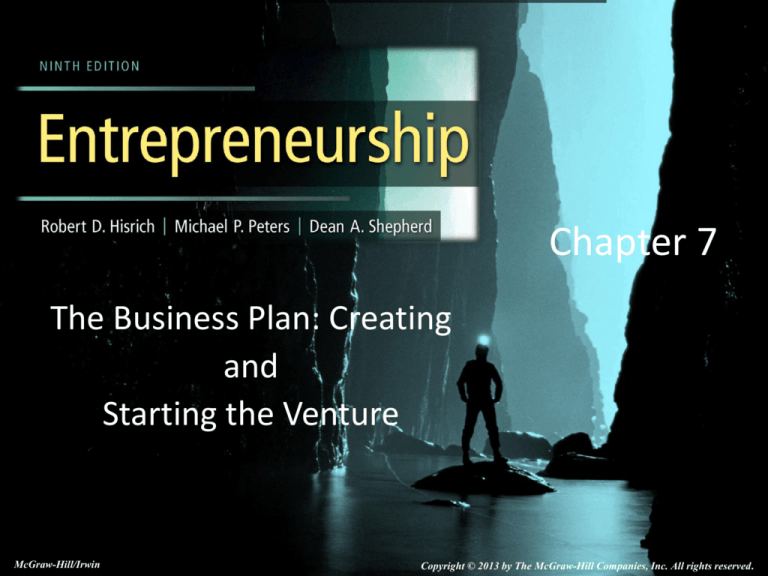
Chapter 7
The Business Plan: Creating
and
Starting the Venture
© 2014 by McGraw-Hill Education. This is proprietary material solely for authorized instructor use. Not authorized for sale or distribution in any manner. This document
McGraw-Hill/Irwin
Copyright
© 2013 by The McGraw-Hill Companies, Inc. All rights reserved.
may not be copied, scanned, duplicated, forwarded, distributed, or posted on a website, in whole or
part.
What is the Business Plan?
• Written document describing:
• Relevant internal and external elements
• Strategies for starting a new venture
• Integrates functional plans
• Addresses short and long-term decision
making for the first three years of operation
7-2
What is the Business Plan?
• Prepared by the entrepreneur in consultation
with others
• Requires objective assessment of individual
skills
7-3
Table 7.1 - Skills Assessment
7-4
Scope and Value of the Business
Plan—Who Reads the Plan?
• Scope
• Determined by who is expected to read the plan
• A plan should consider the:
• Entrepreneur’s perspective
• Marketing perspective
• Investor's perspective
7-5
Scope and Value of the Business
Plan—Who Reads the Plan?
• Depth and detail in the business plan depends
on:
•
•
•
•
Size and scope of the proposed new venture
Size of the market
Competition
Potential growth
7-6
Scope and Value of the Business
Plan—Who Reads the Plan?
• Business plan is valuable because it:
• Helps determine the viability of the venture in a
designated market
• Guides the entrepreneur in organizing planning
activities
• Serves as an important tool in helping to obtain
financing
7-7
How do Potential Lenders and
Investors Evaluate the Plan?
• The business plan must reflect:
• Strengths of the management and personnel
• Product/service
• Available resources
• Lenders
• Interested in the venture’s ability to pay back the
debt
• Focus on the four Cs of credit - Character, cash
flow, collateral, and equity contribution
7-8
How do Potential Lenders and
Investors Evaluate the Plan?
• Banks - Interested in analysis of the business
opportunity and risks
• Investors
•
•
•
•
Emphasize on the entrepreneur’s character
Conduct background checks
Demand high rates of return
Focus on market and financial projections
7-9
Presenting the Plan
• An entrepreneur should:
• Focus on why this is a good opportunity
• Provide an overview of the marketing program
• Address risks and how to overcome them
• Investors describe these presentations as
elevator pitches
7-10
Information Needs
• Establish well-defined goals and objectives
• Undertake a feasibility study
• Information for a feasibility study should focus
on marketing, finance, and production
7-11
An Upside-Down Pyramid Approach to
Gathering Market Information
• General environmental and demographic
trends
• National food industry trends
• Local environmental and demographic trends
• Local food industry trends
• Local competition strengths and weaknesses
7-12
Operations Information Needs
•
•
•
•
•
•
•
Location
Manufacturing operations
Raw materials
Equipment
Labor skills
Space
Overhead
7-13
Financial Information Needs
• Prepare a budget listing all possible
expenditures
• Forecast sales revenue on the basis of market
data
• Identify industry benchmarks to prepare the
final pro forma statements
7-14
Using the Internet as a Resource Tool
• Provides information for:
• Industry analysis
• Competitor analysis
• Measurement of market potential
• Is useful for:
• Later-stage planning and decision making
• Provides opportunities for marketing strategy
7-15
Writing the Business Plan
• Introductory page
• Executive summary
• Environmental and industrial analysis
• Environmental analysis: Assessment of external
uncontrollable variables that may impact the
business plan
• Industrial analysis: Reviews industry trends and
competitive strategy
7-16
Writing the Business Plan
• Description of venture: Complete overview of
the products, services, and operations
7-17
Table 7.5 - Critical Issues for
Environmental and Industry Analysis
7-18
Table 7.6 - Describing the Venture
7-19
Writing the Business Plan
• Production plan: Details of how product will
be manufactured
• Operations plan
• Marketing plan: Describes market conditions
and strategy related to:
• How the product and service will be distributed,
priced, and promoted
7-20
Writing the Business Plan
• Organizational plan: Describes:
• Form of ownership
• Lines of authority and responsibility
• Assessment of risk
• Identifies potential hazards and alternative
strategies to meet goals and objectives
7-21
Writing the Business Plan
• Financial plan: Projection of key financial data
that determine:
• Economic feasibility
• Necessary financial investment commitment
• Appendix
7-22
Measuring Plan Progress
• Determines whether the goals or objectives
are on schedule
• Reviews
• Profit and loss statement
• Cash flow projections
• Inventory control
7-23
Measuring Plan Progress
•
•
•
•
•
Production control
Quality control
Sales control
Disbursements
Web site control
7-24
Using and Implementing the Business
Plan
• Updating the plan
• Monitor changes in the company, industry, and
market
• Determine what revisions are needed if changes
are likely to affect the business plan
• Advantages
• Helps maintain reasonable targets and goals
• Increases the probability of success for a new venture
7-25
Why Some Business Plans Fail
• Unreasonable goals
• Non measurable objectives
• Lack of commitment to the business or to the
family
• Lack of experience in the planned business
7-26
Why Some Business Plans Fail
• No sense of potential threats or weaknesses
to the business
• No customer need was established for the
proposed product or service
7-27

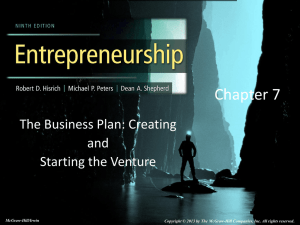


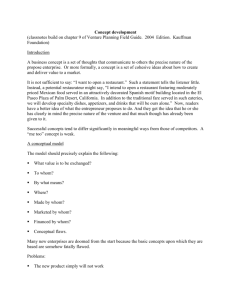

![Chapter 3 – Idea Generation [ENK]](http://s3.studylib.net/store/data/007787902_2-04482caa07789f8c953d1e8806ef5b0b-300x300.png)


